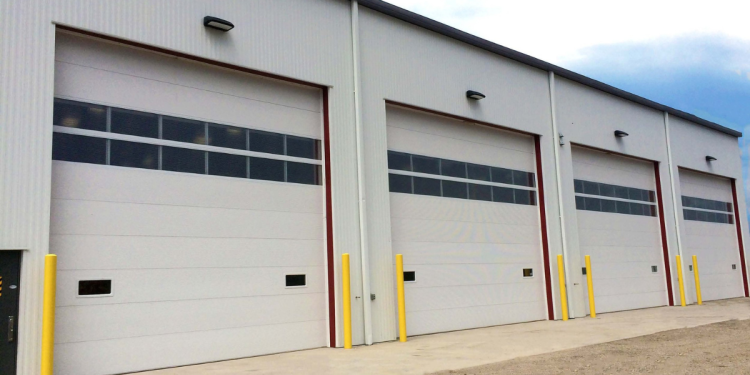Seamlessness of movement is an absolute design necessity, not a choice, in contemporary-day hyperfunctional buildings, residential, commercial, or industrial buildings. Seamless vertical and lateral movement is what maintains traffic flowing, be it a 20-floor vertically rising high rise moving upwards passengers, or a warehouse unloading thousands of kilograms’ worth of stocks each day. Say hello to oft-unrecognized heroes of mechanical movement-the elevator, the Sectional Garage Door, and the dock levelers. Let’s dive deep into how each one among these essential systems work, how they operate, and what you should keep in mind when selecting them for your premises.
Vertical Travel-The Elevator
It is arguably the most ubiquitous vertical transport medium, working out of sight behind smooth doors. Whether up to a rooftop flat or down into the basement car park, the elevator has come to be an integral part of our built environments. Different elevator types of elevators are fitted per the intended function in the building-hydraulic elevators, for example, are usually installed in low to mid-rise buildings. In their configuration, they use pistons and fluid pressure for lifting and lowering the cab.
While cheap, they might be slower and less effective than other types. Traction elevators, by contrast, employ a pulley, rope, and counterweight system. These are more effective, faster, and suitable for high-rise buildings. High-tech traction systems typically come with regenerative drives, which allows them to turn their kinetic power into power again, and hence the green option among developers.
Vacuum elevators, although still rare, use air pressure differentials to move the car. With a tube-like transparent build, they’re a marvel of physics and design, choice often motivated by fashion decisions and space maximization imperatives. But elevators are more than just machines, savvy tech integrations have introduced dimensions of luxury-feel and security maximisation. Destination dispatch systems, biometric control, and smartphone-manipulated motion are becoming the standard. For buildings aimed at universal access, voice control ability and braille within the cab of the lift are helpful with inclusivity for all passengers.
The Sectional Garage Door- Weather-efficiency and Torque
The often-underappreciated Sectional Garage Door is made up of horizontal panels connected by hinges, and it travels vertically and then horizontally along tracks pinned to the ceiling. This allows ultimate space maximisation within and outside the garage. No swing radius is required, which is for narrow premises or locations where each square foot counts. These doors are typically made with insulated panels, offering thermal efficiency and sound dampening, specially useful in storage facilities with perishable items. Most contemporary models have weather seals and wind-resistant elements, which becomes important with coastal locations or stormy locations to prevent erosion or damage to goods.
Automation such as remote access, rolling-code security, and motion sensors offer security and convenience. Some even have cloud connectivity, which allows operators to observe open/close cycles, power consumption, and maintenance needs via a mobile dashboard. The major advantage of these are their impeccable security features- up-to-date sectional doors must meet finger-pinch protection and impact resistance specifications. Power failures or equipment failures allow rapid manual override with the aid of emergency release devices that are mandatory in most territories.
Smoothing the Load with Dock Levelers
On the backend of most logistics enterprises sits an often overlooked but critical piece of equipment, dock levelers. They’re installed out of sight somewhere within loading bays, working unseen between that delivery truck and the business premises floor. The role that dock levelers are tasked with is that of creating a safe, level ramp on which goods, sometimes pallets or trolleys, to transport from trucks and onto warehouses. That’s due to truck suspension or unevenness, and that’s where these hydraulic or mechanical platforms step in. Hydraulic dock levelers offer precise control and are ideal for heavy, regular traffic-based operations. Push-button control makes them safe with minimal workplace injury risk, require minimal manpower, and offer smooth transitions for materials. Mechanical dock levelers, by comparison, employ the use of a series of springs and levers and are lower priced, but slightly labor-intensive. They’re ideal for small operations with light-to-medium traffic.
The most useful metric to consider when investing in Dock Levelers for your premises is the load required-levelers come from 10,000- to 80,000-pound loads. Their own protection often includes the following: anti-slip surfaces, toe guards, and lip extensions that are optimised for safe dock-to-trailer attachment. Increasingly sophisticated warehouses are now including dock levelers with IoT (Internet of Things) for predictive maintenance. Sensors can alert operators when oil pressure is low, when metal fatigue is present, or when the unit hasn’t moved in some time—all that forestall the potential for the risk of operational breakdowns and costly downtime.
Infrastructure- Cost, Time and Function Efficient
Choosing the right systems requires an integrative comprehension of your buildings’ needs, traffic movements, and environmental conditions. From the smooth movement of an elevator’s ascent to the smooth movement of a garage door or the rugged platform of a dock leveler, these devices are all about our space becoming more responsive to the way we inhabit and work. In the end, it’s that elusive background technology that keeps things moving.














